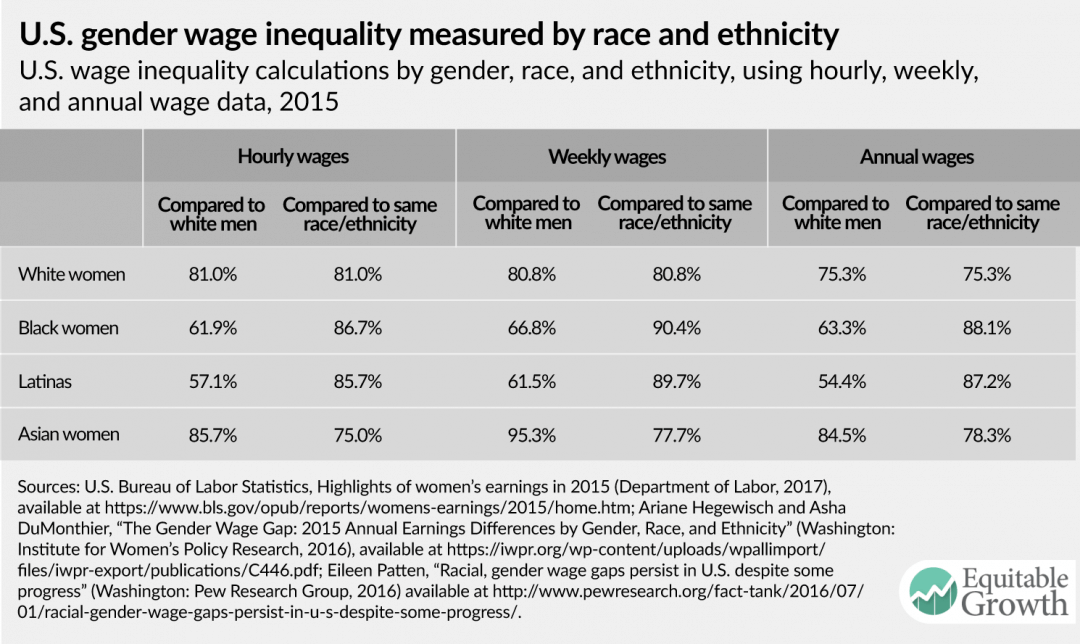Factsheet: Gender wage inequality in the United States and what to do about it

Over the past 40 years, women in the United States increased their work hours, and their rising incomes became a significant part of overall household financial stability. More working women also contributed mightily to stronger economic growth. These additional earnings have made the financial difference for families across races and up and down the income spectrum while also boosting economic growth.
Download FileFact sheet: Gender wage inequality in the United States
Read the full PDF in your browser
Yet despite all of these gains, women are still severely limited by gender pay inequality, which for a number of reasons keeps women’s average earnings at nearly 20 percent less than men’s average earnings. Here are the topline numbers from the Washington Center for Equitable Growth’s new report, “Gender wage inequality: What we know and how we can fix it.”
- Women make up half of the U.S. population (50.8 percent)1 and are close to half of all currently employed workers (46.7 percent).2
- The average earnings of all women who work full time, year round is 80.5 percent (routinely reported as 81 percent) of men who work full time, year round.3 This adds up to total wage differences of more than $799 billion annually.
- The wage gap is worse for black women and Latinas. (See Table 1.)
- Women’s earnings are critical to families’ financial well-being. Women are more likely than men to be single heads of households raising children. And as wages have stagnated, the families that have experienced real, inflation-adjusted income growth since the 1970s are likely to be married couples where the wife works.4
- Women’s earnings also support economic growth. Research finds that if women had not increased their work hours since 1979, GDP in 2012 would have been 11 percent lower than it would have been otherwise, resulting in $1.7 trillion less in output.5
Table 1

What are the causes of gender pay inequality, and what can we do about them?
Work experience
Women have less work experience than men, which explains 14 percent of gender wage inequality—resulting in $112.7 billion in lost wages annually. Gender differences in work experience are largely because women are more likely than men to cut back their work hours or drop out of the labor force altogether due to family and other outside obligations.6 Women are also more likely than men to be part-time workers, who receive lower hourly wages and fewer benefits compared to those doing the same job full-time regardless of gender.7
Policies that make it easier for women and men to be both workers and family caregivers such as paid family and medical leave and public support for universal childcare can help increase women’s work experience by allowing them to remain connected to the labor force.
Industry and occupation
Just more than half of gender pay inequality—50.5 percent—can be explained due to gender differences in the industries (17.6 percent) and occupations (32.9 percent) where men and women work, amounting to a combined estimate of about $404 billion dollars in wage differences. Wages tend to be lower in occupations that are women-dominated compared to men-dominated occupations of similar skill and education level.8 In fact, evidence suggests that an influx of women into a given occupation lowers overall wages.9
Policies such as raising the federal minimum wage can mitigate some of the effects of occupational segregation across the country by raising pay in women-dominated, low-wage professions. In addition, solutions that address the shortage of women in high-wage jobs such as those in the science, technology, engineering, and mathematics fields can help to raise women’s incomes.
Race
Racial wage inequality compounds the effects of gender wage inequality for women of color and, according to models employed in the new Equitable Growth report, explains 4.3 percent of gender wage inequality. The effect of race persists even when controlling for other workers’ characteristics such as education, work experience, and occupation.
Policies that address the legacy of institutional and interpersonal racism in the United States can lessen the racial disparity in wages. In addition, policies that allow workers access to additional hours or to workplace schedules that accommodate additional employment can decrease underemployment, which is higher for workers of color than for white workers.
Region
Regional differences in pay are to be expected, given that the cost of living varies across states. In the absence of inequality, those effects should be evenly spread across men and women. But research finds that regional differences affect women’s wages relative to men’s wages by 0.3 percent, amounting to an estimated $2.4 billion dollars in wage differences.
Because regional differences have a statistically significant relationship to gender wage inequality, national laws are necessary to level the playing field for all workers. State-based equal pay laws and raising state minimum wage levels can and do play an important role in mitigating regional gender inequality, but nationwide policies to address continuing gender pay inequality are necessary.
Discrimination and gender stereotyping
A portion of gender pay inequality—38 percent—is unexplained by observable data, and results in an estimated $304 billion in lost wages annually. Most researchers attribute this portion to factors such as discrimination and socially constructed gender norms such as the fact that women are often encouraged to pursue or are seen as more “suitable” for different kinds of jobs than men.10 Evidence also strongly suggests that the other explanatory factors mentioned in the paper are directly or indirectly influenced by discrimination and gender stereotyping, which affects the choices men and women make about their careers or the (often incorrect) factors that employers use to evaluate productivity.11
To combat discrimination in the workplace, policymakers can turn to solutions that increase pay transparency, allow for more collection of data around gender and wages, and increase enforcement of anti-discrimination laws. These steps can be taken at the federal, state, and municipal levels of government.
Factors that diminish pay inequality
Education
Women’s increased educational attainment has helped narrow differences between women and men by 5.9 percent. Since the 1980s, women have been outpacing men in educational attainment. Yet women and men in the same college major or graduate school programs have persistent differences in the sub-specialties within majors and graduate degree programs and have divergent career paths following graduation.
Policies to make education more affordable can further increase the number of women who pursue postsecondary education. In addition, policies to accommodate the needs of student parents, most of whom are women, can support increased educational attainment among women.
Unionization
Unions elevate wage floors and promote more equitable earnings for all workers, which in turn diminish gender inequality by 1.3 percent. While unions have an impact on workers who are not part of a collective bargaining agreement because of changing norms around rates of pay, women with union contracts had wages that were 9.2 percent higher than those without in 2016, the most recent year for which complete data are available. Workers of color also experienced wage boosts through unionization.
Strengthening the rights of workers to collectively bargain can help to further increase wages for women in the workplace. In addition, policies that increase the bargaining power of workers in women-dominated industries such as domestic work can help to increase women’s wages.12
Conclusion
Sarah Jane Glynn, the author of the new report, concludes “Gender wage inequality: what we know and how we can fix it” with several telling observations. “Unequal pay between women and men drags down the growth of the U.S. economy and threatens the economic security and retirement security of working families,” she writes. “Building a strong economy that works for everyone is not possible unless gender pay discrimination is fully addressed. Adequately addressing gender wage inequality will require taking an all-inclusive approach, simultaneously focusing on discrimination alongside factors such as occupational segregation and the United States’ lack of work-family policies.
End Notes
1. U.S. Bureau of the Census, Age and Sex, 2011-2015 American Community Survey 5-Year Estimates, American Community Survey (Department of Commerce, 2016), available at https://factfinder.census.gov/bkmk/table/1.0/en/ACS/15_5YR/S0101.
2. U.S. Bureau of Labor Statistics, Table A-1. Employment status of the civilian population by sex and age (Department of Labor, 2017), available at https://www.bls.gov/news.release/empsit.t01.htm.
3. Bernadette D. Proctor, Jessica L. Semega, and Melissa A. Kollar, “Income and Poverty in the United States: 2016” (Washington: U.S. Census Bureau, 2016), available at https://www.census.gov/content/dam/Census/library/publications/2017/demo/P60-259.pdf.
4. Heather Boushey, Finding Time: The Economics of Work-Life Conflict (Cambridge, MA: Harvard University Press, 2016).
5. Eileen Appelbaum, Heather Boushey, and John Schmitt, “The Economic Importance of Women’s Rising Hours of Work” (Washington: Center for American Progress and the Center for Economic and Policy Research, 2014), available at https://cdn.americanprogress.org/wp-content/uploads/2014/04/WomensRisingWorkv2.pdf.
6. Gary N. Powell and Jeffrey H. Greenhaus, “Sex, gender, and decisions at the family→ work interface,” Journal of Management 36 (4) (2010): 1011–1039.
7. In 2017, there were roughly 125,967,000 full-time employed workers age 16 and older, 54,396,000 of whom were women. There were an additional 27,370,000 part-time workers, 17,539,000 of them women. U.S. Bureau of Labor Statistics, Table 8. Employed and unemployed full- and part-time workers by age, sex, race, and Hispanic or Latino ethnicity (Department of Labor, 2018), available at https://www.bls.gov/cps/cpsaat08.htm. Also see: Lonnie Golden, “Still falling short on hours and pay: Part-time work becoming new normal” (Washington: Economic Policy Institute, 2016), available at http://www.epi.org/publication/still-falling-short-on-hours-and-pay-part-time-work-becoming-new-normal/.
8. Ariane Hegewisch and others, “Separate and not equal? Gender segregation in the labor market and the gender wage gap” (Washington: Institute for Women’s Policy Research, 2010), available at https://iwpr.org/wp-content/uploads/wpallimport/files/iwpr-export/publications/C377.pdf.
9. Christine L. Williams, “The glass escalator: Hidden advantages for men in the “female” professions,” Social problems 39 (3) (1992): 253–267; Asaf Levanon, Paula England, and Paul Allison, “Occupational feminization and pay: assessing causal dynamics using 1950-2000 US census data,” Social Forces 88 (2) (2009): 865–891.
10. Francine D. Blau and Lawrence M. Kahn, “The gender wage gap: Extent, trends, and explanations,” Journal of Economic Literature 55 (3) (2017): 789–865.
11. Hegewisch and others, “Separate and not equal? Gender segregation in the labor market and the gender wage gap”; Marianne Bertrand, Claudia Goldin, and Lawrence F. Katz, “Dynamics of the gender gap for young professionals in the financial and corporate sectors,” American Economic Journal: Applied Economics 2 (3) (2010): 228–255.
12. Josh Bivens and others, “How today’s unions help working people: Giving workers the power to improve their jobs and unrig the economy” (Washington: Economic Policy Institute, 2017), available at http://www.epi.org/publication/how-todays-unions-help-working-people-giving-workers-the-power-to-improve-their-jobs-and-unrig-the-economy/#epi-toc-10.






